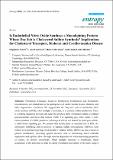| dc.contributor.author | Seneff, Stephanie | |
| dc.contributor.author | Lauritzen, Ann | |
| dc.contributor.author | Davidson, Robert M. | |
| dc.contributor.author | Lentz-Marino, Laurie | |
| dc.date.accessioned | 2013-03-06T18:03:15Z | |
| dc.date.available | 2013-03-06T18:03:15Z | |
| dc.date.issued | 2012-12 | |
| dc.date.submitted | 2012-11 | |
| dc.identifier.issn | 1099-4300 | |
| dc.identifier.uri | http://hdl.handle.net/1721.1/77582 | |
| dc.description.abstract | Theoretical inferences, based on biophysical, biochemical, and biosemiotic considerations, are related here to the pathogenesis of cardiovascular disease, diabetes, and other degenerative conditions. We suggest that the “daytime” job of endothelial nitric oxide synthase (eNOS), when sunlight is available, is to catalyze sulfate production. There is a striking alignment between cell types that produce either cholesterol sulfate or sulfated polysaccharides and those that contain eNOS. The signaling gas, nitric oxide, a well-known product of eNOS, produces pathological effects not shared by hydrogen sulfide, a sulfur-based signaling gas. We propose that sulfate plays an essential role in HDL-A1 cholesterol trafficking and in sulfation of heparan sulfate proteoglycans (HSPGs), both critical to lysosomal recycling (or disposal) of cellular debris. HSPGs are also crucial in glucose metabolism, protecting against diabetes, and in maintaining blood colloidal suspension and capillary flow, through systems dependent on water-structuring properties of sulfate, an anionic kosmotrope. When sunlight exposure is insufficient, lipids accumulate in the atheroma in order to supply cholesterol and sulfate to the heart, using a process that depends upon inflammation. The inevitable conclusion is that dietary sulfur and adequate sunlight can help prevent heart disease, diabetes, and other disease conditions. | en_US |
| dc.language.iso | en_US | |
| dc.publisher | MDPI AG | en_US |
| dc.relation.isversionof | http://dx.doi.org/10.3390/e14122492 | en_US |
| dc.rights | Creative Commons Attribution 3.0 | en_US |
| dc.rights.uri | http://creativecommons.org/licenses/by/3.0/ | en_US |
| dc.source | MDPI Publishing | en_US |
| dc.title | Is Endothelial Nitric Oxide Synthase a Moonlighting Protein Whose Day Job is Cholesterol Sulfate Synthesis? Implications for Cholesterol Transport, Diabetes and Cardiovascular Disease | en_US |
| dc.type | Article | en_US |
| dc.identifier.citation | Seneff, Stephanie et al. “Is Endothelial Nitric Oxide Synthase a Moonlighting Protein Whose Day Job Is Cholesterol Sulfate Synthesis? Implications for Cholesterol Transport, Diabetes and Cardiovascular Disease.” Entropy 14.12 (2012): 2492–2530. | en_US |
| dc.contributor.department | Massachusetts Institute of Technology. Computer Science and Artificial Intelligence Laboratory | en_US |
| dc.contributor.mitauthor | Seneff, Stephanie | |
| dc.relation.journal | Entropy | en_US |
| dc.eprint.version | Final published version | en_US |
| dc.type.uri | http://purl.org/eprint/type/JournalArticle | en_US |
| eprint.status | http://purl.org/eprint/status/PeerReviewed | en_US |
| dspace.orderedauthors | Seneff, Stephanie; Lauritzen, Ann; Davidson, Robert; Lentz-Marino, Laurie | en |
| dc.identifier.orcid | https://orcid.org/0000-0001-8191-1049 | |
| mit.license | PUBLISHER_CC | en_US |
| mit.metadata.status | Complete | |
